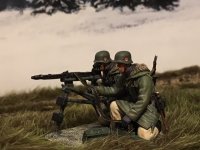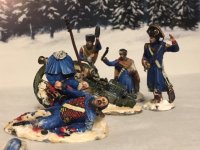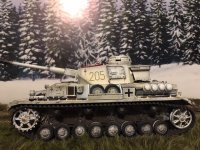You are using an out of date browser. It may not display this or other websites correctly.
You should upgrade or use an alternative browser.
You should upgrade or use an alternative browser.
What Toy Soldier items Have You Acquired in The Last 2 Weeks ? (3 Viewers)
- Thread starter PanzerAce1944
- Start date
villagehorse
Lieutenant General
- Joined
- Feb 5, 2010
- Messages
- 16,632
Very nice, these are on the horizon for me. Robin.
TomNT
Lieutenant Colonel
- Joined
- May 7, 2011
- Messages
- 7,986
Very nice, these are on the horizon for me. Robin.
Robin, I can see my Nubian Water Carrier coming over the horizon in the postal truck! {sm3}^&grin
Tom
marco55
Brigadier General
- Joined
- Feb 18, 2008
- Messages
- 11,629
I backed a Kickstarter last of a new line of 28mm French & Indian War figures. Last week I received a blockhouse,cabin and 55 packs (over 200) of figures.They came out very nice. https://www.kickstarter.com/projects/2057721466/sash-and-saber-28mm-french-and-indian-war-miniatur.
Mark
Mark
Mirof
Sergeant Major
- Joined
- Apr 1, 2013
- Messages
- 1,625
These guys came in a bag from a thrift store. I do not know what they are, so I painted them as communist military police.
View attachment 247821
Communist police in red ? In what movie ?
Perhaps Security Gard as seen by Chinese
https://french.alibaba.com/product-...rt-uniforms-red-guard-uniform-1482156353.html
Or the Red Gard in Sénégal
Or the mounted Canadian Police :tongue:
Michel
Louis Badolato
Lieutenant General
- Joined
- Apr 25, 2005
- Messages
- 18,442
ccdc11
Sergeant First Class
- Joined
- Sep 14, 2010
- Messages
- 1,171
I am taking a break from all spending as we are planning on a move soon, so this will be my last batch unless it's something I have been chasing or K&C Egypt.
WarPark tank and new figures, The Manes Marzano retreat from Russia arrived damaged but I will get it fixed.
Only one more set of these to go!
WarPark tank and new figures, The Manes Marzano retreat from Russia arrived damaged but I will get it fixed.
Only one more set of these to go!
Attachments
tdubel
Lieutenant Colonel
- Joined
- Jan 18, 2007
- Messages
- 7,156
Latest is a diorama from Little Lead Soldiers - Titanic Grand Staircase. Peter brought it out of retirement and scratch built for me. He is also responsible for the dioramas featured in the James Bond Living Daylights film. Grateful he agreed to reproduce it! Notice yes there are still straw supports, I have not unpacked totally, this was a shot before fully packing it.
Attachments
villagehorse
Lieutenant General
- Joined
- Feb 5, 2010
- Messages
- 16,632
Tom stunning. Suggest you unpack quickly as this is destined for the ocean floor shortly ^&grin, Robin.
tdubel
Lieutenant Colonel
- Joined
- Jan 18, 2007
- Messages
- 7,156
Tom stunning. Suggest you unpack quickly as this is destined for the ocean floor shortly ^&grin, Robin.
No Kidding! Always said that everytime the movie came on, you already know the ending! For whatever reason, Titanic has always fascinated me and these type of scenes are interesting to me. This is the same Company that did the Shackleton Diorama I have.
Stunning scenes. Just need the space. He also produced a Princess Diana funeral procession which I have. Somber moment, stunning scene. I think I even might have him reintroduce the King Arthur set he did as while it might not be the highest quality like my Aeroart version, he does the entire background, etc, so it looks like a full scene.
TD
wayne556517
Lieutenant General
- Joined
- Aug 28, 2007
- Messages
- 16,962
Impressive mate and a great subject matter
Arnhemjim
Corporal
- Joined
- Aug 28, 2009
- Messages
- 404
Around 2005, when e-Bay was still in its halcyon era, I missed a Greenwood & Ball figure of an officer of the 30th Lancers (Gordon's Horse). Very seldom find anything interesting on e-Bay anymore. Recently a group of figures from the collection of COL Sam W. Floca, Jr. showed up. A specific one was displayed in front of a box labeled Greenwood & Ball 27th Punjabis Indian Officer R-3824, which it was not, even though advertised as such. Recognized the near mint condition figure (truly unfortunate many showed varying degrees of lead rot), as either 29th Lancers (Deccan Horse), Set No. GB30F or 30th Lancers (Gordon's Horse), Set No. GB30(?), didn't matter as experts know both regiments wore exactly identical uniforms (exception being either gilt 29L or 30L titles on the silver coloured shoulder chains. On arrival found it to be labeled 29 Lancers Deccan Horse in Ms. Ball's style on underside of base, along with impressed Greenwood & Ball logo. Based on all characteristics believe the figure to have been sculpted and painted in the mid 50's. Consider myself extremely fortunate.
Arnhem Jim
Arizona Territory
Arnhem Jim
Arizona Territory
Attachments
Alexander the Great
Staff Sergeant
- Joined
- Mar 9, 2017
- Messages
- 809
Around 2005, when e-Bay was still in its halcyon era, I missed a Greenwood & Ball figure of an officer of the 30th Lancers (Gordon's Horse). Very seldom find anything interesting on e-Bay anymore. Recently a group of figures from the collection of COL Sam W. Floca, Jr. showed up. A specific one was displayed in front of a box labeled Greenwood & Ball 27th Punjabis Indian Officer R-3824, which it was not, even though advertised as such. Recognized the near mint condition figure (truly unfortunate many showed varying degrees of lead rot), as either 29th Lancers (Deccan Horse), Set No. GB30F or 30th Lancers (Gordon's Horse), Set No. GB30(?), didn't matter as experts know both regiments wore exactly identical uniforms (exception being either gilt 29L or 30L titles on the silver coloured shoulder chains. On arrival found it to be labeled 29 Lancers Deccan Horse in Ms. Ball's style on underside of base, along with impressed Greenwood & Ball logo. Based on all characteristics believe the figure to have been sculpted and painted in the mid 50's. Consider myself extremely fortunate.
Arnhem Jim
Arizona Territory
I just found out about Greenwood and Ball figures, they look amazing but what is the story and why are they rare? I am assuming that the company stopped making them?...they ebay prices for one figure are very high, would love some info on this company...
Arnhemjim
Corporal
- Joined
- Aug 28, 2009
- Messages
- 404
I just found out about Greenwood and Ball figures, they look amazing but what is the story and why are they rare? I am assuming that the company stopped making them?...they ebay prices for one figure are very high, would love some info on this company...
Hello "Alexander"
The following article may or may not be more than you ever wanted to know about Greenwood & Ball figures. With both thanks and acknowledgement to Malcolm Peel who wrote;
"The firm of Greenwood & Ball is known to all collectors of model soldiers. Figures made at its tiny workshop at Horsehay adorn dioramas in museums all over the world, and are to be found on training tables in many of the principal military academies of the west.
The founder of the firm was John Ambler Greenwood, a salesman, born in Yorkshire, whose territory included Shropshire. About 1936 he happened to be staying overnight at the shop in Spring Village, Horsehay, where he played chess with Kathleen Ball, the shop keeper’s daughter. After a game or two, Mr Greenwood thought he would improve on the figures, and “dress” them up a bit. He fashioned a number of chess figures, such as knights in full armour, using “toy” soldiers and plastic wood, coupled with a bit of filing and carving.
The interest grew from a hobby to a business. He gave up his job, and he and Miss Ball teamed up to make model soldiers employing two girls to help.
Greenwood & Ball did many dioramas including one depicting the battle of Crecy for West Point military academy in America, and several for the King Charles Tower on the walls of Chester depicting the Civil War. During the Second World War, Greenwood & Ball supplied figures for military training tables, on which operations such as the Dieppe raid were rehearsed. In 1947 they made the figures for the Battle for Freedom Exhibition in London, which portrayed British history in a series of scenes, from the signing of the Magna Carta in 1215 to the crossing of the Rhine in 1945. He also invented a game of indoor cricket.
It was followed by a substantial contribution to a United States exhibition of the pageant of Jewish history, depicting outstanding events in that people’s history from ancient times to the establishment of the state of Israel.
Production of the models was first begun in 1936 at the home Miss Ball, which was the small village shop in Spring Village, Horsehay. Later, production switched to a workshop which occupies a building often referred to as the old laboratory, and was at one time the Horsehay Home Guard guardroom. The workshop consisted of two rooms above the old weighbridge opposite the engine shed at Horsehay Works. Mr. Greenwood was a Captain in the Home Guard during the war, and so would be familiar with this building, and because of its use at that period; it looks as if they must have occupied it after the Second World War.
Miss Kathleen Ball married Mr John A. Nathaniel, a quantity surveyor, in Edinburgh in 1951 and she later set up home there. The business remained at Horsehay until about 1956 when they moved to workshop in Broseley Wood. Here they employed only one painter while Mr Greenwood continued making the models, moulds and castings and Kathleen did the assembly and soldering. Greenwood & Ball’s clientele included American collectors, including film legend Douglas Fairbanks Jnr, who had over 6,000 figures. There is a story that Fairbanks visited the firm, although we haven’t come up with first hand proof that he did.
John Greenwood moved to West Ayton near Scarborough in April 1959 and continued making the models and fishing in the Derwent near his home, a pastime which gives him time to think of new ideas for his business. He passed away in 1971 at the age of 78 years.
In September 1985, Mrs Kathleen Nathaniel, nee Ball, donated to the Ironbridge Gorge Museum about 250 models, of which the Director Mr. Stuart B Smith, described as the most valuable collection of objects which the Museum has yet been given."
The figures depicting the Scottish and Indian regiments of the British Army are particularly exceptional, being very well researched and executed. You might be interested in glancing at the following article I have posted on my blog page; http://arnhemjim.blogspot.com/2012/10/officers-of-scottish-regiments-of.html
Best regards,
Arnhemjim
Arizona Territory
Alexander the Great
Staff Sergeant
- Joined
- Mar 9, 2017
- Messages
- 809
Hello "Alexander"
The following article may or may not be more than you ever wanted to know about Greenwood & Ball figures. With both thanks and acknowledgement to Malcolm Peel who wrote;
"The firm of Greenwood & Ball is known to all collectors of model soldiers. Figures made at its tiny workshop at Horsehay adorn dioramas in museums all over the world, and are to be found on training tables in many of the principal military academies of the west.
The founder of the firm was John Ambler Greenwood, a salesman, born in Yorkshire, whose territory included Shropshire. About 1936 he happened to be staying overnight at the shop in Spring Village, Horsehay, where he played chess with Kathleen Ball, the shop keeper’s daughter. After a game or two, Mr Greenwood thought he would improve on the figures, and “dress” them up a bit. He fashioned a number of chess figures, such as knights in full armour, using “toy” soldiers and plastic wood, coupled with a bit of filing and carving.
The interest grew from a hobby to a business. He gave up his job, and he and Miss Ball teamed up to make model soldiers employing two girls to help.
Greenwood & Ball did many dioramas including one depicting the battle of Crecy for West Point military academy in America, and several for the King Charles Tower on the walls of Chester depicting the Civil War. During the Second World War, Greenwood & Ball supplied figures for military training tables, on which operations such as the Dieppe raid were rehearsed. In 1947 they made the figures for the Battle for Freedom Exhibition in London, which portrayed British history in a series of scenes, from the signing of the Magna Carta in 1215 to the crossing of the Rhine in 1945. He also invented a game of indoor cricket.
It was followed by a substantial contribution to a United States exhibition of the pageant of Jewish history, depicting outstanding events in that people’s history from ancient times to the establishment of the state of Israel.
Production of the models was first begun in 1936 at the home Miss Ball, which was the small village shop in Spring Village, Horsehay. Later, production switched to a workshop which occupies a building often referred to as the old laboratory, and was at one time the Horsehay Home Guard guardroom. The workshop consisted of two rooms above the old weighbridge opposite the engine shed at Horsehay Works. Mr. Greenwood was a Captain in the Home Guard during the war, and so would be familiar with this building, and because of its use at that period; it looks as if they must have occupied it after the Second World War.
Miss Kathleen Ball married Mr John A. Nathaniel, a quantity surveyor, in Edinburgh in 1951 and she later set up home there. The business remained at Horsehay until about 1956 when they moved to workshop in Broseley Wood. Here they employed only one painter while Mr Greenwood continued making the models, moulds and castings and Kathleen did the assembly and soldering. Greenwood & Ball’s clientele included American collectors, including film legend Douglas Fairbanks Jnr, who had over 6,000 figures. There is a story that Fairbanks visited the firm, although we haven’t come up with first hand proof that he did.
John Greenwood moved to West Ayton near Scarborough in April 1959 and continued making the models and fishing in the Derwent near his home, a pastime which gives him time to think of new ideas for his business. He passed away in 1971 at the age of 78 years.
In September 1985, Mrs Kathleen Nathaniel, nee Ball, donated to the Ironbridge Gorge Museum about 250 models, of which the Director Mr. Stuart B Smith, described as the most valuable collection of objects which the Museum has yet been given."
The figures depicting the Scottish and Indian regiments of the British Army are particularly exceptional, being very well researched and executed. You might be interested in glancing at the following article I have posted on my blog page; http://arnhemjim.blogspot.com/2012/10/officers-of-scottish-regiments-of.html
Best regards,
Arnhemjim
Arizona Territory
Truly amazing, imagine having the opportunity to have visited the workshop back then. Amazing figures and the history makes them even more unique!
Thank you!!!
Warrior
Lieutenant General
- Joined
- May 12, 2005
- Messages
- 16,026
No Kidding! Always said that everytime the movie came on, you already know the ending!
TD
For those of us not familiar with the story, please try not to ruin it by giving away the ending.
Thanks for your consideration.
Users who are viewing this thread
Total: 4 (members: 0, guests: 4)













